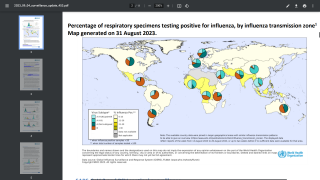Mammals Consuming Sick Birds Become Infected with Avian Influenza

New research highlights multiple detections of Highly Pathogenic Avian Influenza (HPAI) A(H5N1) virus Eurasian lineage H5 clade 2.3.4.4b in wild terrestrial mammals in the United States.
This finding, published by the U.S. CDC Emerging Infectious Diseases Volume 29, Number 12—December 2023, builds on previous reports of natural infections with HPAI virus in red foxes and adds to the global list of species susceptible to H5N1 HPAI virus.
Intrinsic factors related to exposure and infection risk could explain this finding, including opportunistic dietary preferences, likelihood of sharing environments with infected birds, abundance of immunologically naive animals present during the onset of the avian outbreak, and potentially increased susceptibility to infection in this species.
Affected mammals include 50 red foxes (Vulpes vulpes), six striped skunks (Mephitis mephitis), four raccoons (Procyon lotor), two bobcats (Lynx rufus), 2 Virginia opossums (Didelphis virginiana), one coyote (Canis latrans), one fisher (Pekania pennanti), and 1 gray fox (Urocyon cinereoargenteus).
Many red foxes were found in urban or periurban environments, and extrinsic factors, such as human interest in the highly visible animals, might have led to increased public reporting.
Raccoons, skunks, opossums, and coyotes are generalist mesopredators frequently encountered in urban and periurban areas, and these species were less represented is unclear.
Ingestion of birds infected with HPAI virus is presumed to be the most likely source of infection in wild mammals, and three red foxes in this study had evidence of bird ingestion.
Wild birds, including waterfowl, are a typical or occasional component of the natural diet in those species, and infection following ingestion of HPAI virus-positive birds has been confirmed in multiple mammals, raptors, and scavenging birds.
However, clear evidence of mammal-to-mammal transmission was not apparent in these cases.
But horizontal transmission of HPAI H5N1 virus has been documented in experimentally infected domestic cats and ferrets, and transmission from an infected parent or conspecific cannot be ruled out as a potential source of infection in some of the mammals in this study, particularly within affected littermates.
According to the CDC, eleven human cases of H5N1 have been reported globally since December 2021.
Although serologic evidence of exposure to Avian Influenza Viruses (AIVs) has been documented in many wild mammal species, few experiments have investigated the susceptibility of wild mammals to these viruses, and even fewer specifically to the HPAI H5N1 virus.
Neurologic signs were the primary clinical observation in this report.
Most clinically ill mammals in this study died or were euthanized because of disease progression, similar to outcomes reported in other natural infections with HPAI H5N1 virus in mammals.
The scattered geographic and temporal distribution of the HPAI virus‒infected mammals in this study suggests that these infections represent sporadic spillover events into individual animals sharing the landscape with HPAI virus‒infected wild birds.
This theory is supported by sequencing data from mammalian samples, confirming the presence of several different genotypes that have also been documented emerging and circulating in the United States in wild birds.
In mammals, sustained deaths caused by the HPAI H5N1 virus have thus far only been reported in seals, and methods of transmission responsible for the outbreak remain unclear.
In summary, these researchers demonstrate that multiple North American wild terrestrial mammal species are susceptible to natural infection with the HPAI H5N1 virus of Eurasian lineage goose/Guangdong H5 clade 2.3.4.4b, probably by ingestion of infected wild birds.
Given the ongoing nature of the HPAI virus outbreak and the detection of genetic substitutions concerning mammalian adaptation, surveillance for the HPAI virus in wild mammals would contribute to a better understanding of the distribution and evolution of these viruses in free-ranging wildlife, wrote these researchers on November 18, 2023.
Communications: Dr. Elsmo is an assistant professor of clinical diagnostic veterinary pathology at the Wisconsin Veterinary Diagnostic Laboratory and the University of Wisconsin School of Veterinary Medicine, Madison, Wisconsin.
The entire unedited research is posted at this CDC link.
Bird flu outbreaks were detected in December 2021 in St. John's, Newfoundland and Labrador, Canada. A phylogenetic analysis showed that these viruses were most closely related to HPAI GsGd viruses circulating in northwestern Europe in spring 2021.
In July 2022, a study published by the journal Nature suggested that these viruses may have been carried across the Atlantic via Iceland, Greenland/Arctic, or maritime routes.
As of November 20, 2023, the U.S. government has approved bird flu vaccines such as Audenz™ and continues funding vaccine candidates' studies.
As of June 2023, about 20 million H5N1 and 12 million H7N9 vaccines were available in the U.S. National Strategic Stockpile.
Our Trust Standards: Medical Advisory Committee
























